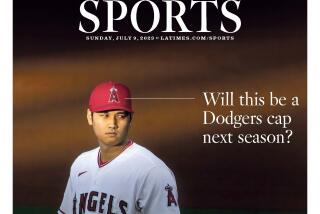Time Magazine Will Roll Out Its New Design : Media: The publication, which has lost circulation to rivals, will have a format that de-emphasizes events of the last week.
- Share via
Time does not stand still.
However, the long-awaited redesign of America’s original newsmagazine is far from a radical leap, to judge by prototypes of the new Time, hitting newsstands today.
“It’s not exactly what I’d call revolutionary. I think you’ll recognize the bloodlines,” said Chrysler Corp. Vice President Bud Liebler, one of numerous advertisers who got an advance briefing from Time executives--and applauded the changes.
In place of such familiar sections as “Nation,” “World” and “Business,” Time has folded its recap of the week’s news into a tighter, front-of-the-book section titled “The Week,” in which no story may run longer than 100 lines.
The guts of the magazine is the 30-page “center well,” which contains longer pieces of an analytical or investigative nature, with larger photos than Time typically has used. The typeface of headlines and stories has been changed to increase readability: In come Century and Madison, out goes Times Roman.
In a bow to tradition, the magazine has brought back the tall, thin Time logo, a cover fixture for decades until supplanted by a chunkier version in a 1977 redesign.
Time, like other news media, has suffered serious advertising declines in the last year. It has also seen rivals Newsweek and U.S. News & World Report creep closer in circulation, with 3.1 million and 2.15 million readers, respectively, to Time’s 4 million.
Time notes that its circulation drop--from a 1988 peak of 4.6 million--was a deliberate strategy to boost profitability.
Meeting with West Coast advertisers two months ago, Time publisher Lisa Valk acknowledged that the magazine “had maybe become dated in some ways,” according to Linda Colleran of the Foote, Cone & Belding ad agency in Santa Ana.
Publishing analyst James D. Doughtery of County NatWest USA in New York said he thinks that Time redesigned because it felt pressured by Newsweek’s circulation gains.
Still, Time insists that the revamp--in the works since November, 1990--was of, by and for the editorial department.
Executive Editor Richard Duncan, in Los Angeles Friday to explain the make-over to advertisers and Time staffers, said its goal is to give Time the flexibility to display stories “according to a hierarchy of news urgency and relevance, rather than some imposed topic category.”
Until now, a long profile of candidate Bill Clinton, for example, would run in the “Nation” section with the latest primary results folded in or alongside. The new Time would put a brief story on the primary in “The Week” and refer readers back to the profile in the center section.
“You get the same analysis,” Duncan said. “You just don’t have to get to it through the rehash of last week’s news.”
Time took extravagant steps to insure the secrecy of the redesign project, dubbed “T2” in newsroom code.
Under an assumed name, staffers rented an uptown Manhattan apartment--quickly nicknamed “the Skunk Works”--where designers with Apple Macintosh computers cranked out prototype pages.
Duncan said he was taken aback by news leaks that led to stories portraying the new version as “Time Lite” or “Harper’s with pictures.”
“We most emphatically didn’t go ‘lite,’ ” he said.
More to Read
Sign up for our Book Club newsletter
Get the latest news, events and more from the Los Angeles Times Book Club, and help us get L.A. reading and talking.
You may occasionally receive promotional content from the Los Angeles Times.










